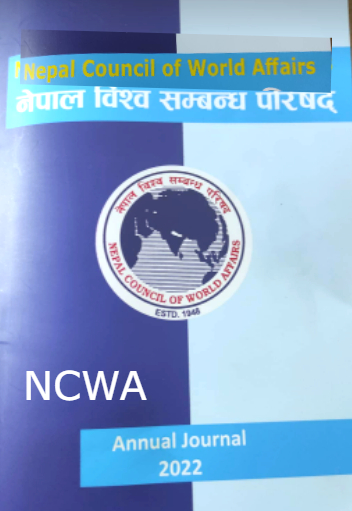Dr. Kamal K. Shrestha
Life Member, Nepal Council of World Affairs ( NCWA)

Abstract:
Interest of Nepal in many nuclear related international treaties initiated by the United Nations is laudable. Nepal has signed important treaties like the Non-Proliferation Treaty (NPT), the Comprehensive Nuclear-Test-Ban Treaty (CTBT) in the past and the Treaty for Prohibition of Nuclear Weapons (TPNW) recently, all of which deserves praise. However, only the NPT has been ratified so far. Ratification of CTBT is overdue. Status of nuclear weapons in the world, nuclear free south Asia, award of Nobel Prize for Peace to TPNW, nuclear doctrine, some relevant topic are also dealt concisely. For the best interest of Nepal, why CTBT and PTNW need to be ratified sooner than later is also discussed in brief.
Introduction:
Pakistan and North Korea all of which have nuclear weapons. The peaceful uses of atomic energy program were initiated in these countries building nuclear reactors for research and production of electricity as well as other applications like food preservation, medical sterilization, use of radioisotopes for nuclear medicine, in industry and in agriculture, etc. Unfortunately, these counties ended up in developing and storing nuclear weapons. It is quite conspicuous that these countries have not signed, all important, Nuclear Non-Proliferation Treaty (NPT). Like Nepal, in our neighborhood, however, Bangladesh and Sri Lanka have signed NPT and both have peaceful uses of nuclear energy. Bangladesh possesses a small nuclear reactor for research and isotopes production as well a big nuclear power plant with an aim to generate 1,000 MW of electricity to meet their energy crisis.
Nepal has been keeping abreast with nuclear related treaties by signing all the important UN initiated nuclear related treaties starting from Partial Test Ban Treaty (PTBT) in 1963, Non-Proliferation Treaty (NPT) in 1973, Comprehensive Nuclear-Test-Ban Treaty (CTBT) in 1975, etc up to the recent, the Treaty for Prohibition of Nuclear Weapons (TPNW) in 2017. However, Nepal has so far ratified PTBT and NPT only but not CTBT
and TPNW. For the national interest and peace in the region, Nepal also needs to take seriously these two nuclear related UN treaties and ratify as soon as possible.
Status of Nuclear Warheads in the world:
Currently, the estimated number warheads in the world are 13,132. It seems the nuclear arsenal of Russia is 6,257 and that of the US is 5,550 while China has 350, France has 290 and UK has 225. Similarly, other countries like Pakistan, India, Israel and North seem to possess 165, 160, 90 and 45 nuclear warheads respectively. On the other hand, Russia has deployed 1,600 and kept on reserve 2,897 warheads while the U.S. has deployed 1,800 and kept in reserve 2,000 warheads. The nuclear arsenal of France is 280 deployed and 10 on reserve while UK has deployed 120 and put on reserve 105 war heads. They, including China also have “triad system” of deployment, that is, delivery of nuclear bombs to specified targets from the air, sea and the ground. India, Israel, Pakistan and North Korea are developing ever more powerful missiles and also making efforts to have “Triad system” of delivery of nuclear bombs.
Partial Test Ban Treaty (PTBT):
The UN treaty banning nuclear weapons tests in the atmosphere, in outer space and under water with an exception of under-ground was launched in Moscow by USA, UK and then USSR in 1963. In short this was addressed as Partial Ban Treaty or PTBT. This treaty has been signed by almost all the States and also ratified, by many. Nepal singed PTBT on 10.10.1963 and ratified on 07.10.1964 like some of the few countries who did so as early as in the year 1963.
Non-Proliferation Treaty (NPT):
The Treaty on the Non-Proliferation of Nuclear Weapons (NPT) is the important international treaty initiated by the UN with the US, the UK and then USSR, now Russia as Depositary which was signed on July 1st, 1968 and became effective from March 5, 1970. The NPT has been signed by 191 countries and many countries have ratified. However, nuclear weapons possessing countries like India, Israel, Pakistan, and North Korea are non-signatory States. This treaty recognizes the US, the UK, Russia, France and China as five Nuclear Weapon States (NSW) and all five have signed it. Furthermore, they have assured in general, not to use their nuclear weapons against Non-NWS States. They also assure not to transfer “nuclear weapons or other nuclear explosive devices” to NNWS. Similarly, NNWS countries who signed the NPT agree not to receive, acquire manufacture nuclear weapons and also agree to the safeguards by the International Atomic Energy Agency (IAEA).
The IAEA is also allowed as a watch dog to verify if the peaceful uses of nuclear knowledge are observed or not by the NNWS. Nepal duly signed and ratified NPT. Nepal has also taken Membership of IAEA and the National Parliament has ratified as required by the statue of IAEA.
Comprehensive Nuclear-Test-Ban Treaty (CTBT):
The CTBT was adopted by UN General Assembly 1996. This treaty that bans nuclear tests in any environment was opened for signature in New York on 24 September 1996. This treaty bans all nuclear explosions – everywhere, by everyone. This treaty will enter into force after it has been ratified by 44 nuclear capable States that formally participated in 1996 Conference on Disarmament. Even after 26 years still eight more States have to ratify it. The Treaty provides an International Monitoring System. The IMS has installed 337 monitoring facilities in different parts of the whole world including in the remote locations such as the Arctic and Antarctic regions. Among other verification technologies, these facilities include 80 radio-nuclides stations and 16 radio-nuclide laboratories to detect radio-nuclides released especially in the atmosphere.
The CTBT aims at eliminating nuclear weapons by constraining the development and qualitative improvement of new types of nuclear weapons. This treaty plays a crucial role in the prevention on nuclear proliferation and in nuclear disarmament.
World opinion is overwhelmingly against nuclear weapons and that they should be abolished. Up to now, among the 193 member countries of the UN, 70 have signed and 55 have ratified TPNW. On January 22nd 2020, the whole world celebrated as TPNW came into force. Honduras took the honor of ratifying the Treaty on 24th October 2020 by signing as the 50th instrument of ratification. It’s so unfortunate that Nepal did not take the honor to be among the 50 nations. According to the chief elements of this Treaty, all nuclear tests are banned, countries possessing nuclear weapons stockpiles need to negotiate with the UN Representatives on the timetables for the phase wise dismantling of each and every nuclear device in their arsenal. This treaty is set to be eventually fully implemented and then, the world will get rid of nuclear weapons. Peace will prevail on this mother earth. To get rid of fear for the global annihilation can come to reality then and humans will rejoice forever.
Nobel Prize for Peace:
The International Physician for Prevention of Nuclear War (IPPNW) was awarded Nobel Prize for Peace in 1985 for their consistent efforts as the name implies. Co-President, Dr. Iva Helfand said in 2007 “Nuclear war, however, small poses a threat and is a concern for whole planet”. Similarly, the International Campaign to Abolish Nuclear Weapons (ICAN) was also awarded Nobel Prize for Peace in 2017 for the untiring efforts for prohibition of nuclear weapons from the world. Nuclear weapons have posed as perpetual menace for human society. The ICAN seeks to outlaw and eliminate all nuclear weapons in the world. The ICAN is praised by Nobel committee for drawing attention to the catastrophic humanitarian consequences of any use of nuclear weapons and for ground-breaking efforts for threshold number countries to ratify TPNW.
Nuclear Doctrine:
India first adopted a “No First Use” policy after its second nuclear test, Pokhran II in 1998. In the following year, the government released a draft emphasizing that nuclear weapons are solely for deterrence and India will pursue a policy of massive “retaliation” only. China also has “No First Policy” but Pakistan has stated the use for tactical purpose only in the battle field. Nuclear doctrine of North Korea is not known.
Nuclear Disarmament:
As the US and Russia possess 90 percent of the total nuclear war heads in the world, nuclear disarmaments efforts have been focused between them. The Strategic Arms Limitation Treaty (SALT) has been signed between the US and Russia. Lots of progress has been made after the signing of SALT II. However, Robert R. Monroe said in 2004 “New low-yield, accurate nuclear weapons would reduce the nuclear threshold and blur the distinction between conventional and nuclear weapons, thus making their use more likely”.
Conclusion:
The world’s nuclear weapons stockpile has declined remarkably from some 70,300 in 1986 to the current 13,132. Still, the sheer number of these weapons of mass destruction if used strategically can destroy the world some 30 times. Mutually assured destruction, so called MAD syndrome still persists. Due to the necessity to retire old nuclear weapons, the decline of the stockpile will continue indicating the proliferation is still underway. On the contrary, other countries like China, Pakistan and India may be perusing to increase their nuclear stockpiles. Israel, however, has never denied or confirmed their nuclear weapon program. North Korea is as unpredictable as ever.
The CTBT and the TPNW are contributing to a safer and more secure world. CTBT has been to stop for the first time development of nuclear weapons by potential countries. On the other hand, leaders of South Asia have proclaimed this region is free of all nuclear weapons which is an awesome achievement for the whole world to fellow suit. These Treaties are also contributing to regional and international peace and security. Member States can also benefit from the utilization of verification regime data in a variety of civil areas, including scientific research, disaster preparedness and meteorological and climate forecasting.
In this nuclear age, along with ratification of CTBT and TPNW, the Zone of Peace proposed by Nepal in 1975 need to be pursued with all seriousness for both security, safety and to live in peace now and assure peaceful coexistence with the world.
End text.
Thanks Nepal Council of World Affairs Annual Journal ( 2022).
Special thanks to the distinguished author Dr. Shrestha and the entire executive team of the NCWA: Ed. Upadhyaya.
References:
Josse, M. R. (1976). Nepal’s Zone of Peace Proposal: A Brief Survey, Souvenir. NCWA.
Government of Nepal. (2007). National Nuclear Policy, Ministry of Education, Science and Technology. Kathmandu.
Perkovich, G. R. (2001). India’s Nuclear Bomb, The Impact on Global Proliferation. Oxford Univ. Press, New Delhi.
Robert, R. M. (2004). “New Threats, Old Weapons”, LA Times-Washington Post
Shrestha, K.K. (2010). “Nepal in the Nuclear Age”, Bulletin. NUSON.
Shrestha, K.K. (2021). “Ratification of Treaty of Prohibition of Nuclear Weapons“.
RCLMT, Souvenir
The New York Times. (2015). Nuclear Fears in South Asia: USA.
Subrahmanyam, K. (1981). Nuclear Myths and Realities – India’s Dilemma, ABC Pub.
House: New Delhi.
Thapa, H.B. (2003). Nuclear Disarmament through Non-Proliferation, The Kathmandu Post: Kathmandu.
# Prof. Dr. Shrestha is a Life Member of NCWA and also Former Member of National Committee for CTBT also National Steering Committee for Atomic Energy of Nepal formed as per the National Atomic Energy Policy (2007).

